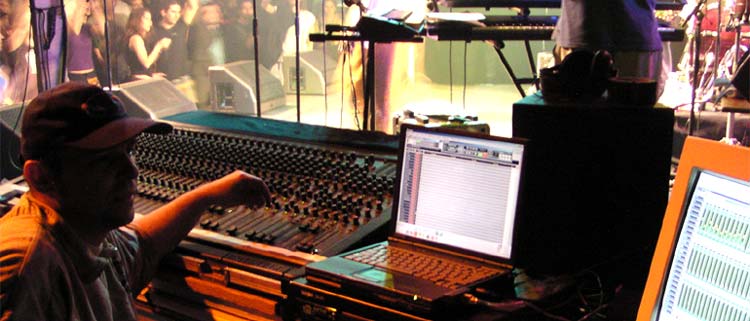Nuendo Live !


Forget it, I won't rub out 15 years of concerts with a single clap of noise gate. So, as soon as I get Nuendo out of its box, the scene called me again... A quick look at the beast immediately convinced me: that thing... it's been done to record live!!!
Why Nuendo?
For many reasons in fact. First for its Surround
Mix functions... While recording live, why wouldn't you make a DVD of
it? And possibly taking advantage of it to do an Authoring with the choice
between the stereo mix and a 5.1 mix? Moreover, when it runs on a steady
computer, Nuendo almost never crashes, and when you are recording live,
it is obvious you need stability...
Another important argument is rather a commercial one: recording with
Nuendo enables to easily export files towards other platforms. In OMF
for Protools or Avid for example if you need to edit with images, or towards
almost anything else depending on your needs. Note that Nuendo manages
rather well video tracks, and it is agreeable to import them for the final
mix.
But its main advantage is its full compatibility with Cubase SX which is very well implanted in the musician and home-made productions environment. So it is rather simple with this system to record a live show in good conditions in multitracks, for the artist himself, and then to give him the multitracks file, so that he can finalize the product in his home studio for a trifling cost.
Computer configuration
Nuendo does not need many resources. So I user machines rather conceived to be stable than powerful. First, I made tests with a quadrixeon server. Powerful, very stable, but very heavy, noisy (especially because of its 700 watts redundant power supply) and very expensive for the spare parts. Hard drives, sold in special drawer to get in hot-plug bays are on that point a real problem when considering archiving cost. Finally, I chose a smaller configuration based on bi-pentium 1GHz, which lasts in a 3U rack. There again, it is largely enough to record live, it is possible to use very less powerful configuration. To give an example, I sometimes use in case of emergency a little Compaq E500 laptop which uses a PIII - 600 MHzwith 256 MB of Ram. I can record with it 26 simultaneous tracks, and it can correctly refresh the Nuendo In vu-meters and draw the wave form in real time, all that during hours without a cough. It is an interesting solution on a tour, because it is easily carried, adding a firewire hard drive being necessary.
As far as sound cards are concerned, I use RME Digiface. These cards are very well conceived concerning their drivers and are extremely stable. They enable too to let the choice of the converters depending on the performance type.
In order to avoid the death crash (is it necessary to precise there is no second take?), the presence of a good inverter is very strongly advised. It guarantees a stable electric supply for the computers, and moreover, it will enable to make a back-up of the recording, even in the case of an electric breakdown. There are models of 1200VA which last in a 2U rack.
Little control room or trailer truck?
In order to properly prepare the recording itself, an element is necessary: the technical forms. Every mean is good to get them... You will mainly need the one(s) of the band(s) which will play, the one of the room (which enables to avoid studying the place before the show) and the one of the technical staff which will be in charge of the sound. The ideal is to be autonomous, but we can drastically reduce the cost by using part of the sound staff equipment (microphones, scene boxes, mixers) to get the signal to the converters. The technical forms enable to check the compatibility of the equipment already in place with the one we intend to bring.
Personally, I add at least a couple of microphones in order to record the ambience of the room, it gives width to the whole and possibly enables to make the work easier on the rear voices in case of a 5.1 mix. Once said, most of the time, it is better to come with a good mixing board, a serious scene box and some exotic microphones in case of. I would advice a good cable tester too, and a controller, several symmetrization transformer and maybe one or two DI.
Sound recording
It is obvious that the most important part of the work is there, in the choice and the placing of the microphones. Quite often, these choices will change whether we take the point of view of the sound staff, or the one of the recorder. The "standard" microphones kits generally don't change much, and nobody really question them: "and one SM57 for the snare pliz Bob!" ;-D
Supposing you decide to replace it by the brand new Neumann KM184 you brought with you; you will have to negotiate with the sound staff, and in this case, a good experience in sound organization can help.
Managing a scene on a live show is often rather difficult. You have to check, and don't have to make it really subtle. So, while everybody is going and coming, you'd better check the state of the mic stands and their placing to avoid they transmit noises to the microphones (shocks, vibrations, etc.), to verify the placing of the microphones and of the monitors to limit the most important feedbacks, and, if it remains a little time, to put some adhesive tape here and there to secure the whole. Another example of possible negotiation with the sound staff: the setting of the drums toms. Most of the time in live, we tend to damp them because it is really difficult to efficiently gate them and because their resonance (especially when the drums are set with the feet!) can trouble in the mix. But, in the recording, these problems are less important because they can be easily solved in the studio, and, on the other hand, having a more profound sound can be a real advantage.
Nuendo settings
Before setting Nuendo, you'd better do one or two benchmarks on the computer to check the hard drive accesses are correct. With UDMA, we can easily obtain real transfer rates of about 40 MB/s in writing and it is a bit better with U160 SCSI. If everything is OK, we can prepare an audio project in Nuendo in which we will create the number of tracks we need (generally between 20 and 30). Making run the project enables to control the behaviour of the gauge, especially the one of the hard drives and of the CPU. If they begin to race, don't panic, a little setting of the buffers size and number should rapidly solve the glitch problems. Once done, we just have to start recording, being careful not to let the cycle mode on!!! ;-)

Photo: Sister Carol, Earl Sixteen, U-Brown & Rod Taylor - Live recording, Paris 2003... © Copyright Serial-P.





